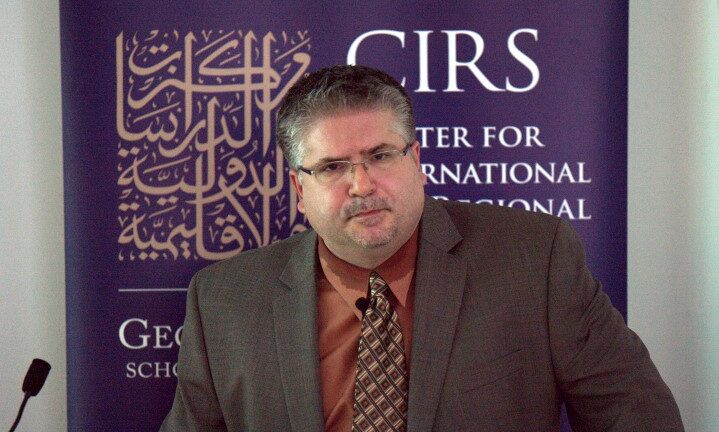Dialogue Series, Race & Society
John Crist on Global Trends in Protest

John T. Crist, Assistant Dean for Academic Affairs at the Georgetown University School of Foreign Service in Qatar and an expert on social movements and peace and conflict studies, delivered his lecture, “From Gandhi to Twitter: Global Trends in Protest,” before a packed house of students, faculty, staff, and community members on November 10, 2009 as part of the CIRSMonthly Dialogue series.
Crist focused on the changing nature of social protest movements in the face of rapid globalization. He pointed to the shift away from activism directed at specific states towards movements and protests that transcend national boundaries.
Using the iconic anti-colonial protests led by Mahatma Gandhi on the Indian subcontinent during the early twentieth century as an example, Crist outlined the traditional state-targeted methods of social activism as a precedent for today’s increasingly borderless transnational protest movements. Contrary to popular perception, Gandhi’s emphasis on nonviolent civil disobedience delivered only partial success, according to Crist. However, nonviolent tactics were invaluable in creating broad popular support for the Indian National Congress. The group was, according to Crist, “the main vehicle that Gandhi and the Gandhians used to disseminate their ideas and their tactics of nonviolent action.” The Indian National Congress came to be recognized as the de-facto opposition government in colonized India, wielding great leverage because of its power as a social movement that mobilized millions against British rule across many constituencies.
Protest trends in the twenty-first century, Crist posited, have reflected the seismic influence of globalization, with interest groups from around the globe banding together to coordinate action. “The single-most important trend in social movements is the move away from the state as the principle target for protest activity,” Crist said. “This, of course, is the result of the power of globalization.”
The increased availability of funding sources, ease of travel, low cost of communication through technologies like the internet, and high-profile transnational forums such as the United Nations, have enabled issues groups to bring their protests to the international stage.
Crist noted that an unprecedented number of transnational coalitions that work to promote their coordinated initiatives and messages in multiple countries are currently being formed. A prime example of the new protest mold is the 350 Campaign, which is an environmental initiative that calls itself “a global grassroots campaign to stop the climate crisis.” According to Crist, on October 24, 2009, the group held concurrent events in 181 countries around the world, including in Qatar, to promote climate change advocacy. It seeks to provide its environmental allies in governments and organizations across the globe with leverage to prompt policy change. Global protest movements such as the 350Campaign hope that their coordinated international efforts will garner the attention of leaders in many nations while at the same time galvanizing local groups to continue their activities.
Crist also touched on the power that new technologies such as SMS-messaging and Twitter have had on grassroots activism. He pointed to the role that Twitter and texting played in orchestrating protests following the Iranian elections of June 2009. Through “tweets,” Iranians were able to send out instantaneous updates about unfolding events to help bolster their struggle, as well as to communicate with the international media outlets that have been barred by the Iranian government. The power of Twitter to influence the actions of the protestors on the ground as well as the international political structure were striking, according to Crist, who asserted that Twitter “had become, overnight, a tool for dramatic social change and a sticking point in U.S.-Iranian relations.”
Ending the lecture, Crist pointed out that not all modern grassroots protests facilitated by these new technologies are successful. Recent political protests in Moldova organized through the social networking site Facebook and through text messaging turned violent. In the absence of strong leadership with a clear message or strategy, Crist said, grassroots protests facilitated by communication technologies can easily become counterproductive or even destructive.
Dr. Crist is Assistant Dean for Academic Affairs at Georgetown University School of Foreign Service in Qatar. He received his Ph.D. in Interdisciplinary Social Science from the Program on the Analysis and Resolution of Conflicts in the Maxwell School of Citizenship and Public Affairs at Syracuse University.
He taught courses in sociology, peace studies, conflict resolution, and research methods at the M.A. in Conflict Resolution Program on the Georgetown University main campus, the School of Advanced International Studies at Johns Hopkins University, Maxwell School at Syracuse University, the Peace Studies Program at Colgate University, and the Department of Sociology at the Catholic University of America. Professor Crist published journal articles and book reviews on social movements, nonviolent action, and the policing of demonstrations. He edited a special issue of the Journal of Contemporary Ethnography on ethnographic fieldwork in war zones and post-conflict settings. As a fellow of the Albert Einstein Institution, he conducted extensive archival research in England and India on the politics of nonviolent mobilization during the Gandhian anti-colonial struggle in India.
Article by Clare Malone. Clare is a Student Affairs Officer at the Georgetown University School of Foreign Service in Qatar.